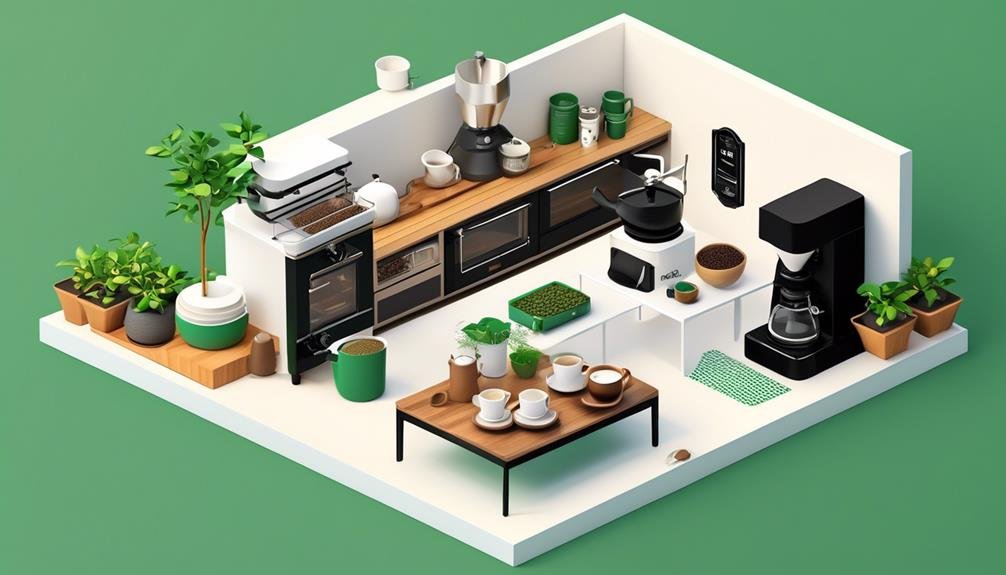As you embark on your journey to master the art of home roasting coffee, you'll soon discover that the equipment you choose is like the conductor of an orchestra, orchestrating the perfect harmony of flavors and aromas.
From the humble coffee roaster to the essential digital scale, each piece plays a crucial role in achieving that perfect roast.
But what exactly is needed? Well, my friend, let's dive into the world of home coffee roasting and uncover the essential equipment that will elevate your coffee experience to new heights.
Key Takeaways
- Coffee roaster is the essential equipment for home coffee roasting.
- Considerations when choosing a coffee roaster include type, capacity, and control options.
- Roasting your own beans allows for experimentation with different beans and roast profiles.
- Green coffee beans are the raw, unroasted beans that can be sourced from various places, and quality and ethical sourcing are important factors to consider.
Coffee Roaster
To achieve the freshest and most flavorful coffee, invest in a coffee roaster, which allows you to roast your own beans at home. A coffee roaster is an essential piece of equipment for any coffee enthusiast who wants to take their coffee experience to the next level. Roasting your own coffee beans allows you to have control over the flavor profile, ensuring that every cup of coffee you brew is tailored to your preferences.
There are various types of coffee roasters available, ranging from small countertop models to larger drum roasters. The most common types are hot air roasters and drum roasters. Hot air roasters use heated air to roast the beans, while drum roasters utilize a rotating drum that heats the beans through direct contact.
When choosing a coffee roaster, consider the capacity, control, and ease of use. The capacity determines how much coffee you can roast at once, so choose a roaster that suits your needs. Look for a roaster that offers precise control over temperature and timing, as this is crucial for achieving the desired roast level. Additionally, opt for a roaster that's user-friendly and easy to operate, especially if you're new to home roasting.
Investing in a coffee roaster opens up a world of possibilities for experimenting with different coffee beans and roast profiles. By roasting your own beans, you can enjoy the freshest coffee and have the satisfaction of creating a truly personalized cup of joe.
Green Coffee Beans
If you're ready to explore the next step in home coffee roasting, it's time to dive into the world of green coffee beans. Green coffee beans are the raw, unroasted seeds of the coffee plant. They are called "green" because of their natural green color before they undergo the roasting process. These beans are what you need to start your home roasting journey and truly customize your coffee experience.
To help you understand the different types of green coffee beans available, here is a table that outlines some popular varieties:
| Variety | Flavor Profile |
|---|---|
| Arabica | Smooth, sweet, and complex |
| Robusta | Bold, strong, and bitter |
| Ethiopian | Fruity, wine-like, and floral |
| Colombian | Balanced, nutty, and caramel |
| Brazilian | Chocolatey, nutty, and low acidity |
As you can see, each variety offers its own unique flavor profile, allowing you to experiment and find your favorite. Green coffee beans can be purchased from various sources, including local coffee shops, online retailers, and even directly from coffee farms. When selecting your beans, look for ones that are high-quality, ethically sourced, and suited to your taste preferences.
Digital Scale

Using a digital scale is essential for precise and accurate measurements when home roasting coffee. A digital scale allows you to measure the exact amount of green coffee beans needed for each batch, ensuring consistency in the roast. It also helps you to calculate the appropriate ratio of beans to water, resulting in a well-balanced cup of coffee.
When choosing a digital scale for home roasting, look for one that has a high level of accuracy, preferably with a precision of at least 0.1 grams. This will enable you to measure small amounts of coffee with great precision. Additionally, opt for a scale with a large weighing capacity, as this will allow you to roast larger batches if desired.
A digital scale with a tare function is also highly recommended. This feature allows you to zero out the weight of your container or brewing equipment, so that you only measure the weight of the coffee beans. It saves you from having to do calculations manually and ensures accurate measurements.
Remember to calibrate your digital scale regularly to maintain accuracy. This can be done using calibration weights or by following the manufacturer's instructions.
Ventilation System
Why is a ventilation system crucial for home coffee roasting? When roasting coffee at home, it is important to have proper ventilation to ensure the safety and quality of your roasting process. Roasting coffee beans releases smoke and volatile compounds that can be harmful if inhaled in large quantities. A ventilation system helps to remove these byproducts and maintain a clean and healthy environment in your home.
To understand the importance of a ventilation system, consider the following table:
| Issue | Risk | Solution |
|---|---|---|
| Smoke and fumes | Inhalation of toxic compounds | Install an exhaust fan or use a vent hood to remove smoke and fumes from the roasting area. |
| Heat | Overheating and discomfort | Use a fan to circulate air and cool the roasting area. |
| Odor | Lingering smell in the house | Use an air purifier or open windows to eliminate any lingering odor.
Cooling Tray

To ensure a successful home coffee roasting experience, the next essential component to discuss is the cooling tray, which plays a crucial role in preserving the quality and flavor of the freshly roasted beans. After the beans have been roasted to perfection, they need to be cooled down quickly to stop the roasting process and prevent over-roasting. This is where the cooling tray comes in handy.
Here are three key features to consider when selecting a cooling tray:
- Material: Opt for a cooling tray made of a heat-conductive material like stainless steel or aluminum. These materials facilitate rapid heat transfer, ensuring that the beans cool down quickly and evenly.
- Size: The size of the cooling tray should match the batch size you typically roast. It should be spacious enough to hold all the beans in a single layer, allowing for efficient cooling.
- Design: Look for a cooling tray with a perforated surface. The perforations allow for proper airflow, aiding in the cooling process by allowing hot air to escape and fresh air to circulate around the beans.
Investing in a high-quality cooling tray won't only enhance the taste and aroma of your home-roasted coffee but also extend the shelf life of the beans by preventing them from becoming stale due to excessive heat.
Storage Containers
A crucial aspect of properly storing your freshly roasted coffee beans is selecting the right storage containers. When it comes to preserving the flavor and freshness of your home-roasted coffee, it's important to choose containers that can effectively protect the beans from exposure to air, light, moisture, and heat.
One popular option is airtight glass jars with rubber gasket seals. These containers not only prevent air from entering but also offer a clear view of the beans, making it easy to monitor their condition.
Another common choice is stainless steel canisters with airtight lids. Stainless steel containers aren't only durable but also provide excellent protection against light and moisture.
Vacuum-sealed bags are also a popular choice for coffee storage. These bags remove air from the package, preventing oxidation and maintaining freshness. Additionally, they're often lined with a foil barrier to block out light and moisture.
Whatever storage container you choose, make sure it has a tight seal and is stored in a cool, dark place away from direct sunlight and heat sources. By selecting the right storage containers, you can ensure that your freshly roasted coffee beans stay flavorful and aromatic for longer periods.
Roast Log

One helpful tool to track and document your home coffee roasting journey is a roast log. Keeping a roast log allows you to record important information about each roast, such as the bean type, roast level, roast time, and any notes or observations you have. This log becomes a valuable resource for improving your roasting skills and replicating successful roasts.
Here are three key items to include in your roast log:
- Bean Type: Start by recording the specific type of coffee beans you're roasting. This could be a single-origin bean or a blend of different beans. Knowing the bean type helps you understand the flavor profiles and characteristics to expect from your roast.
- Roast Level: Document the desired roast level for each batch. This could range from light to dark, depending on your preference. By noting the roast level, you can track your progress and make adjustments to achieve the desired roast profile.
- Roast Time: Record the duration of each roast. This includes the time it takes for the beans to reach first crack and the total roast time. Monitoring the roast time helps you maintain consistency and make adjustments for future roasts.
Frequently Asked Questions
Are There Any Specific Safety Precautions to Consider When Using a Coffee Roaster at Home?
When using a coffee roaster at home, it's important to consider safety precautions. Make sure to read and follow the manufacturer's instructions. Use protective gear like oven mitts and goggles. Keep a fire extinguisher nearby, just in case.
How Long Does It Typically Take to Roast Coffee Beans at Home?
To roast coffee beans at home, you'll need specific equipment. The time it takes to roast beans varies depending on factors like the roast level and the equipment used. It can range from 10 to 20 minutes.
Can I Roast Coffee Beans in a Regular Oven or Microwave Instead of Using a Coffee Roaster?
You cannot roast coffee beans in a regular oven or microwave. Coffee roasting requires specific equipment, such as a coffee roaster, to ensure even heating and proper control over temperature and airflow.
What Are the Best Types of Green Coffee Beans for Home Roasting?
To home roast coffee, you'll need a few key pieces of equipment. A coffee roaster, preferably one with temperature control, is essential. You'll also need a scale, a timer, and a cooling tray.
Is It Necessary to Use a Ventilation System When Roasting Coffee at Home, or Are There Alternative Methods to Control Smoke and Odor?
To control smoke and odor when roasting coffee at home, it is necessary to use a ventilation system. This will ensure that the air is properly circulated and the smoke and odor are effectively removed from your roasting area.
Conclusion
To successfully home roast coffee, it's essential to have the right equipment. A coffee roaster is the heart of the operation, allowing you to control the roast levels. Green coffee beans provide the raw material, while a digital scale ensures accurate measurements.
A ventilation system keeps the roasting area smoke-free, and a cooling tray quickly cools down the beans after roasting. Storage containers keep your freshly roasted coffee fresh, and a roast log helps you track and refine your roasting process.
With these tools, you can embark on your coffee roasting journey with confidence and precision.




